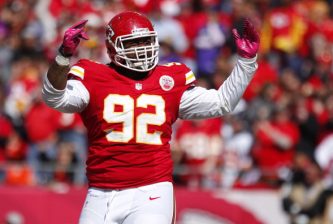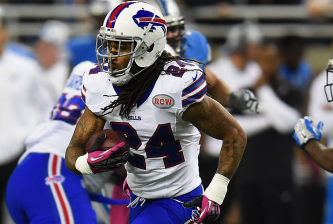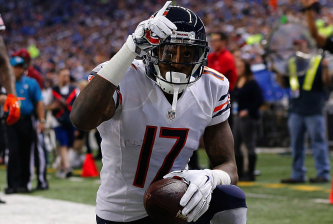For first year players, projecting their rookie seasons provides a difficult, two-part dynamic: College scouting report and production, and rookie season team situation. Some top talents have injuries or situation stifle their rookie year potential, while other lesser talents get the benefit of their team’s needs to produce at a high level.
While each team would love for one of their draft picks to battle for “Rookie of the Year”, they are more concerned about each prospects development and promise of success in year three, four, five and beyond.
But for impatient fans and fantasy football owners alike, the question of “what can he do for the team now?”, projecting a player without any NFL film proves a tough task. Here’s how I project the top rookie quarterbacks, running backs and receivers for their rookie seasons, using their college film, current situation, and similar player output/comparisons in the past.
Quarterbacks
- Jameis Winston, Tampa Bay Bucs
61% Completion Percentage, 3200 yards, 22 touchdowns, 14 interceptions
Winston has already been named the team’s starting quarterback, but that’s far from a sure bet that he’ll be able to produce in the team’s season opener. He’s drawn praise in training camp and has showed both his polish and need for development in pre-season.
While he’s viewed as a one of the most polished college passers in some time, his current NFL situation isn’t conducive to a breakout rookie year. Sure, his offense boasts Mike Evans, one of the league’s best receivers, and past productive veterans Vincent Jackson and Doug Martin. But the Bucs offensive line is the worst in the NFL (battling with the Washington Redskins for that title), and should do Winston no favors this year.
- Marcus Mariota, Tennessee Titans
64% Comp. Percentage, 2800 yards, 16 touchdowns, 9 interceptions
600 rushing yards, 5 touchdowns
It’s still unclear at this point if/when Mariota will takeover as the team’s starting quarterback job, as Zach Mettenberger won’t be giving it up willingly. But Mariota was drafted to be the team’s future, and as soon as the team feels he’s ready (or whenever the GM calls down to Ken Whisenhunt to let him know it’s time), Mariota will be in the game and leading this franchise for the forseeable future.
Mariota is one of the more difficult rookies to project, because his efficiency and running ability will allow him to be conservatively productive, but we won’t see the high swings in output or big-play ability until the offensive gameplan is totally set up for Mariota’s skill set, which may not happen as a rookie. I think an efficient, short-range passing game with some read-option designs should be expected for the rookie in Tennesseee.
Running Backs
- Melvin Gordon, San Diego Chargers
250 carries, 1200 yards, 8 TDs; 15 receptions, 120 yards, 0 TDs
Melvin Gordon, of the most impressive college running backs in recent years, takes over the San Diego Chargers running game, one of the least consistent units in 2014. The Chargers averaged just 3.65 yard per carry in 2014, forced to use Brandon Oliver as the lead runner for a large part of the season.
Looking back to 2013, Ryan Matthews lead the team with 255 carries, 1255 yards and 6 touchdowns, numbers that Melvin Gordon should replicate if healthy. Gordon offers the rare combination of patience and elite turn-the-corner speed on the perimeter, consistently able to pick up positive yardage and take advantage of openings linebackers allow.
He won’t get much work on third down players due to the Chargers other running backs, but he’ll likely be the feature back for most of the season and a high-end RB2.
- Todd Gurley, St. Louis Rams
200 carries, 970 yards, 9 TDs; 30 receptions, 300 yards, 2 TDs
Due to Gurley’s body type, physicality as an interior runner, and big play ability despite being 230+ pounds, he has and will continue to receive plenty of Adrian Peterson comparisons. Peterson had a remarkable rookie season that included a new single game rushing record and rookie of the year honors.
Despite the hurdles of needing to beat out Tre Mason and overcoming injury for the first game or two of the regular season, Gurley’s elite talent should make the fears of drafting him worth it.
The Rams have loaded up on offensive linemen (though it’s unclear how NFL-ready they’ll be in 2015) the last two drafts and the offense will be built around Gurley. Adrian Peterson averaged 95 yards per game in his rookie season, and I think Gurley could have similar season-end numbers, despite potentially missing the first game or two.
- Ameer Abdullah, Detroit Lions
170 carries, 800 yards, 4 TDs; 15 receptions, 120 yards, 1 TD
After a highly productive career at Nebraska, Abdullah became a favorite among draft evaluators due to his quickness, low center of gravity against contact, and big play ability on interior runs. But while it didn’t cause him to slip in the draft, Abdullah’s small hands and smaller stature gave some evalutors, myself included, cause for concern in terms of fumbling issues and durability.
College evaluation aside, Abdullah is an awesome situation to produce as a rookie and be a key part of a highly productive offense. He’ll be splitting time with Joique Bell to start the season, and has the potential to be a 20 carry a game runner by mid-season. Bell will likely retain goal line carries and Theo Riddick will be the lead receiver out of the backfield, but there should be close to 200 touches for Abdullah as a rookie, if not more.
- TJ Yeldon, Jacksonville Jaguars
240 carries, 940 yards, 5 TDs; 15 receptions, 90 yards, 0 TDs
Last off-season, the Jaguars invested in Toby Gerhart, hoping he could be the lead back in an offense that needed to have a stabilizing force as they tried to build the defense. Gerhart’s expectations were a major bust, and he was relegated to back-up duty during the year, dealing with injuries and inconsistency.
Yeldon, drafted with the expectation of being the feature back in 2015 and beyond, has little competition for lead back duties in Jacksonville, as the team’s depth chart is littered with more situational runners.
However, Yeldon’s lack of elite athletic upside or big play ability should limit some expectations in year one, at least fantasy-wise, and Alabama runner struggles (outside of the massive Eddie Lacy) should give some pause. He should produce a better version of Bishop Sankey’s rookie year production, but that’s the comparison that tempers my expectations.
- Tevin Coleman, Atlanta Falcons
160 carries, 660 yards, 6 TD; 15 receptions, 100 yards, 0 TDs
Atlanta was in the bottom third of the league in rushing carries, yards per carry, and rushes longer than 20 yards. Despite drafting Devonta Freeman in the 4th round last year, the Falcons opted to draft another early round running back to replace the now retired Steven Jackson.
Coleman, a bit of an upright, plant and go running back, offers a different skill set than Freeman, and the two could split carries pretty evenly after training camp. However, Coleman likely offers just as good receiving ability if not better, and is a more complete between the tackles runner.
The Falcons aren’t afraid to utilize their perceived depth at the position, which may further cut into Coleman’s carries.
- Duke Johnson, Cleveland Browns
100 carries, 400 yards, 3 TDs; 45 receptions, 350 yards, 2 TDs
After entering 2014 with free agent signing Ben Tate, mid-round college-productive rookie Terrance West, and high-upside undrafted signing Isaiah Crowell, the Browns running back unit had ample potential to get at least a little excited.
A year later, the Browns already moved on from Ben Tate (during the 2014 season), Terrance West is 4th on the depth chart, and only Crowell has shown signs of being at least a rotational back. Enter Duke Johnson, who’s big play ability and versatility may be relied upon instantly and in multiple areas of the offense.
He’s still recovering from an early training camp injury, but he’ll assume the #2 back on the depth chart and he’ll likely stay there all season, as long as Crowell can stay healthy, because he’ll also be used as the team’s best short-area receiving threat. He should fill a Shane Vereen-like role for Cleveland, with much of his value being a pass-catching threat, but offers more homerun ability as a runner and run-after catch option.
7/8. David Cobb/David Johnson
Bishop Sankey didn’t seize his feature back opportunity, but he’s assumed to be the 20-25 carry-a-game runner. For Titans rookie David Cobb, he has 2013 Zac Stacy upside based on running style and opportunity if/when Sankey shows he’s not a feature back for the Titans.
One of the best pass-catchers and pass-blockers in recent draft history, David Johnson should have an instant impact in that area. But he’s struggled to earn touches in training camp, so much so that Arizona brought in Chris Johnson to help Andre Ellington share the load. Still, once he’s acclimated to the NFL-level, Johnson could still be a mid-season impact player.
Wide Receivers
1. Amari Cooper, Oakland Raiders
80 receptions, 920 yards, 5 touchdowns
Amari Cooper is both highly refined for a college receiver and couldn’t be in a better situation to thrive in year one in Oakland. Cooper will be the feature receiver in an offense that offers a highly thought of young.
Quarterback (Derek Carr), running back depth (Latavius Murry and Roy Helu Jr), and a scheme that plays into Cooper’s strengths. Cooper has great after catch ability on underneath routes that can set up double move vertical plays for Derek Carr, and has already proven his NFL-readiness in training camp and the pre-season.
I wouldn’t expect production like Odell Beckham Jr. or Mike Evans because he’ll be the most schemed against member of the Raiders offense, but he’ll be a volume receiver with more than a few 100-yard games as a rookie. I look to what Allen Robinson of Jacksonville did before he got hurt a year ago as a baseline for Cooper’s per game averages and potential in 2015.
2. Nelson Agholor, Philadelphia Eagles
75 receptions, 900 yards, 4 touchdowns
From a player’s perspective, playing in a Chip Kelly offense is an awesome opportunity, as you’re used to the best of your abilities only, not asked to shoulder a heavy load, and have plenty of chances for big plays and touchdowns.
From a fantasy perspective, Chip Kelly players should be selected with caution and pessimism. Many coaches say that they want to put players in a position to succeed, but Kelly will truly change his entire gameplan and offensive focuses week-to-week, and wildly different outputs should be expected for every player in the offense.
However, after watching Nelson Agholor throughout Eagles camp develop a relationship with Sam Bradford, along with producing in the Eagles first pre-season game, it’s clear the Eagles have high expectations for the rookie. He’ll first need to clearly beat out Josh Huff for 1st team duties. But when that finally happens, 80-85 receptions isn’t out of the question.
3. Devin Funchess, Carolina Panthers
70 receptions, 850 yards, 6 touchdowns
During the 2015 NFL Draft process, I was a big fan of Devin Funchess, keeping him as a first-round prospect throughout his senior season in a dreadful Michigan offense. But after being drafted to Carolina to play with Kelvin Benjamin, a player who his skills merely duplicate, question marks arose about whether Funchess would find long-term success in the Panthers offense.
However, with Kelvin Benjamin out for the season, Funchess can thank fate for his potential breakout rookie season. He’s stil developing as a receiver after playing just one year of college at the position, but his ball skills, box out ability, and physicality after the catch should give Cam Newton a great mid-field threat. He’s similar, but doesn’t win as a receiver in the same areas as Benjamin. As long as the Panthers offense can understand and still feed him the ball in the mid-field, he could be a highly productive surprise rookie receiver.
4. DeVante Parker, Miami Dolphins
40 receptions, 650 yards, 5 touchdowns
Before the 2015 NFL Draft, we had Devante Parker above Kevin White, and I was told there was a possibility he could have gone before White in the weeks leading up to the draft. The Dolphins landed their second most coveted target (first was Todd Gurley) with the 14th pick, and he’ll be expected to take over as the #1 receiver during the season.
However, receiver isn’t a position that is easy to transition into. Parker’s value as a mid-field target with great extension away from his frame, finishing ability and run after catch ability should translate well, but other routes and areas of the field may not be refined until later in the season.
Devante Parker will start the season injured and will have an uphill battle to take back starting opportunities. Add in that the team already has two established young receivers in Kenny Stills and Jarvis Landry to assume most of the early season targets, along with veteran Greg Jennings, the pressure won’t be on for Parker to produce. But by mid-season, I’d look for Parker to emerge as one of Ryan Tannehill’s best weapons in the mid-field.
5. Breshad Perriman, Baltimore Ravens
30 receptions, 550 yards, 3 touchdowns
As I got the opportunity to watch the Ravens up close during their three-day joint practice with the Eagles, it’s clear that the Ravens are hurting for a number two receiver opposite the 36 year old Steve Smith. Breshad Perriman, the team’s first round pick out of UCF, was projected to fill that role, but a training camp injury has kept him from his development and valuable reps with Joe Flacco.
While he should be 100% by the start of the season, he’s a raw receiver who was always going to need at least a few weeks of the regular season to be somewhat NFL ready. Still, due to the team’s need of a vertical threat, Perriman has Torrey Smith upside in the offense, especially after the team’s bye week in Week 9.
6. Dorial Green-Beckham, Tennessee Titans
25 receptions, 450 yards, 2 touchdowns
Justin Hunter’s recent assault will likely push him off the Titans roster, leaving a void for second-round Dorial Green-Beckham to potentially fill. But he hasn’t played football in over a year, and there’s no clear timetable for when he’ll be ready to contribute. He’ll need time, but could be a Kelvin Benjamin-like breakout later in the year.




